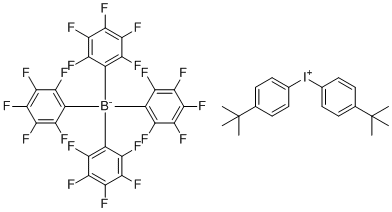Online Database of Chemicals from Around the World
| Jiangsu Nengyue New Material Technology Co., Ltd. | China | Inquire | ||
|---|---|---|---|---|
 |
+86 13376001577 | |||
 |
robin@jiangsunengyue.com | |||
 |
WhatsApp: +8613376001577 | |||
| Chemical manufacturer since 2022 | ||||
| chemBlink standard supplier since 2024 | ||||
| Classification | Organic raw materials >> Organoboron compounds |
|---|---|
| Name | Bis(p-tert-butylphenyl)iodonium tetrakis(pentafluorophenyl)borate |
| Molecular Structure |  |
| Molecular Formula | C24BF20.C20H26I |
| Molecular Weight | 1072.36 |
| CAS Registry Number | 198641-40-6 |
| SMILES | C1(=C(C(=C(C(=C1F)F)[B-](C2=C(C(=C(C(=C2F)F)F)F)F)(C3=C(C(=C(C(=C3F)F)F)F)F)C4=C(C(=C(C(=C4F)F)F)F)F)F)F)F.C5=CC(=CC=C5[I+]C6=CC=C(C=C6)C(C)(C)C)C(C)(C)C |
| Melting point | 77-79 ºC |
|---|---|
|
Bis(p-tert-butylphenyl)iodonium tetrakis(pentafluorophenyl)borate is a specialized iodonium salt used primarily as a photoinitiator in polymerization reactions. Iodonium salts have been known for their capability to generate reactive species when exposed to light, which makes them valuable in various industrial processes. This compound, with its bulky tert-butylphenyl groups and pentafluorophenylborate anion, was developed to improve the efficiency and solubility of iodonium-based photoinitiators, particularly in systems requiring high-performance polymerization initiation under ultraviolet (UV) or visible light. The key feature of Bis(p-tert-butylphenyl)iodonium tetrakis(pentafluorophenyl)borate lies in its iodonium cation, which undergoes photolytic decomposition when exposed to light. This process generates phenyl radicals and an iodonium ion, both of which are highly reactive species that can initiate polymerization. The bulky tert-butyl groups on the phenyl rings stabilize the cation and enhance the compound’s solubility in organic solvents. This increased solubility allows for better dispersion in polymer matrices, making it highly effective in a range of industrial applications. The tetrakis(pentafluorophenyl)borate anion is a large, weakly coordinating anion, which plays a crucial role in maintaining the reactivity of the iodonium cation. Its electron-withdrawing fluorine atoms reduce nucleophilicity, allowing the cation to remain highly reactive and efficient in initiating polymerization. Additionally, this anion enhances the compound’s solubility in non-polar organic solvents, expanding its usability across various photopolymerization systems. One of the primary applications of Bis(p-tert-butylphenyl)iodonium tetrakis(pentafluorophenyl)borate is in UV-curable coatings and inks. The compound’s ability to rapidly initiate polymerization upon exposure to light allows for the fast curing of coatings, leading to improved production efficiency in industries such as automotive, electronics, and packaging. UV-curable coatings are prized for their durability, chemical resistance, and environmentally friendly nature, as they require no volatile organic compounds (VOCs). In the electronics industry, this compound is used in the manufacture of photoresists, which are critical for the production of printed circuit boards and semiconductor devices. Photoresists must be able to transfer fine patterns onto substrates with high precision, and Bis(p-tert-butylphenyl)iodonium tetrakis(pentafluorophenyl)borate’s excellent photoinitiating properties make it ideal for these high-resolution applications. The biomedical field also benefits from the use of this iodonium salt, particularly in dental materials and medical devices. UV-curable resins used in dental restorations, for instance, rely on efficient photoinitiators to ensure rapid curing and long-lasting performance. The compound’s high reactivity ensures strong bonding and minimizes the time needed for light exposure during dental procedures, which is beneficial for both patients and practitioners. The discovery of this compound was driven by the need for improved performance in photoinitiators, particularly in systems requiring high reactivity and good solubility in non-polar solvents. The synthesis typically involves the reaction of iodophenyl derivatives with tert-butylphenyl groups, followed by the introduction of the tetrakis(pentafluorophenyl)borate anion through metathesis. The resulting compound is then purified and characterized for its photoinitiating efficiency, particularly in UV-curable applications. |
| Market Analysis Reports |
| List of Reports Available for Bis(p-tert-butylphenyl)iodonium tetrakis(pentafluorophenyl)borate |